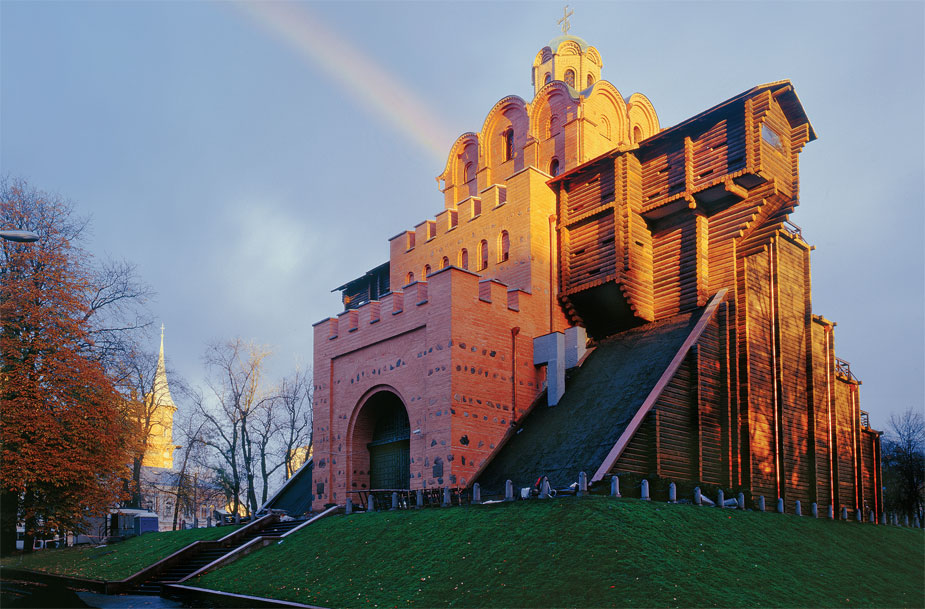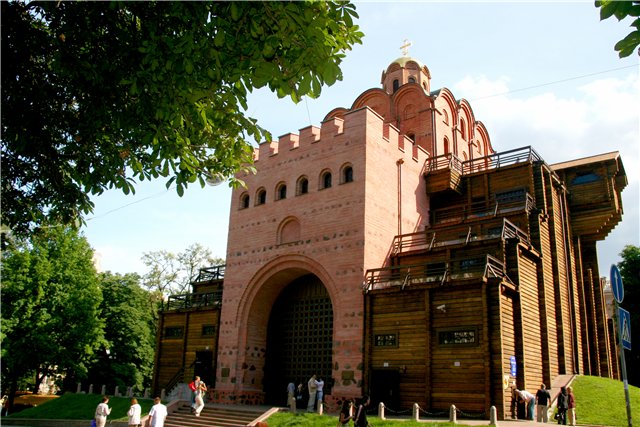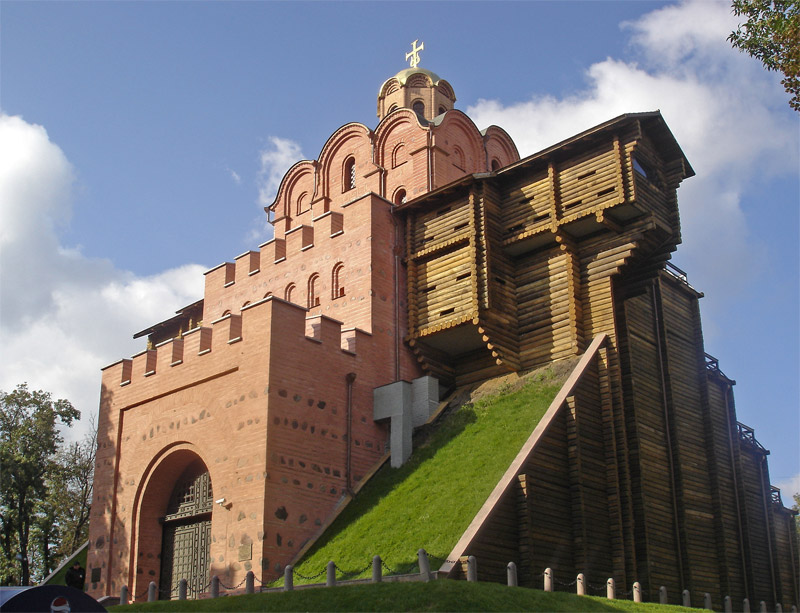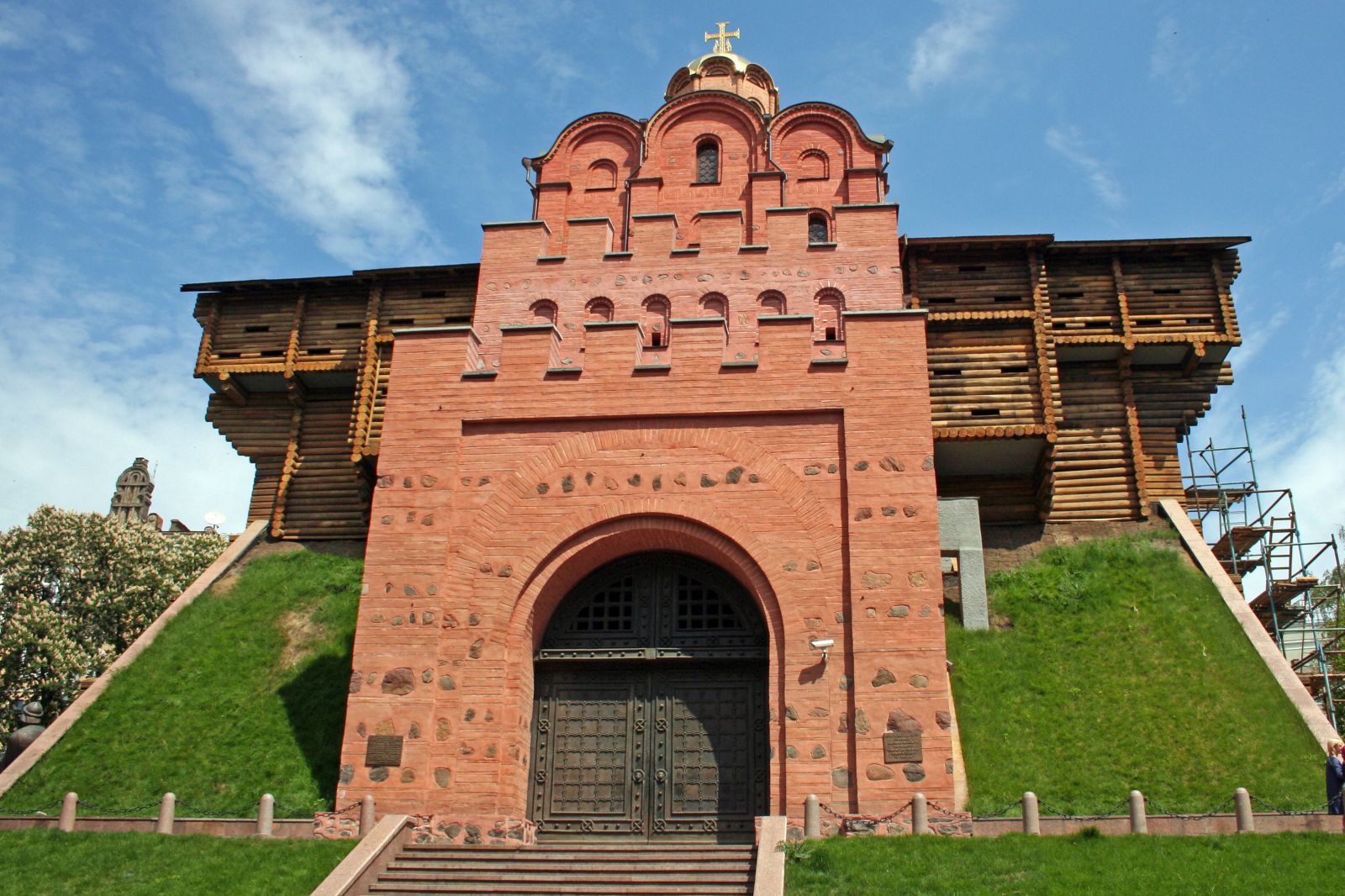The Golden Gates of Kiev (Ukrainian: Золоті ворота, Zoloti vorota) was the main gate in the 11th-century fortifications of Kiev, the capital of Ancient Rus. It was named in imitation of the Golden Gate of Constantinople. The structure was dismantled in the Middle Ages, leaving few vestiges of its existence. It was completely rebuilt by the Soviet authorities in 1982, though no images of the original gates have survived. This decision has been immensely controversial, since there are many competing reconstructions of what the medieval gate might have looked liked.
The rebuilt structure on the corner of Volodymyr street and Yaroslaviv Val Street (Yaroslav's Moat) contains a branch of the National Sanctuary "Sophia of Kyiv" museum. The name Zoloti Vorota is also used for a nearby theatre and a station of the Kiev Metro.
Modern history accepts this gateway as one of three constructed by Yaroslav the Wise. The golden gates were built in 1017-1024 (6545 by the Byzantine calendar) at about the same time the Saint Sophia Cathedral was erected. While some believe that the gates stood some time before that - as depicted, for example, in a painting by Jan Matejko that portrays Bolelaw Chrobry and Sviatopolk I entering the city during the Kiev succession crisis in 1018 - this is now regarded as legend. Originally named simply the Southern Gate, it was one of the three main entrances to the walled city, along with the Lyadski and Zhydivski (Polish and Jewish) Gates. The latter two have not survived. The stone fortifications stretched for only 3.5 km (~2.5 mi). The fortification of the Upper City (Fortress) stretched from the Southern Gates down to what is now Independence Square and where the Lechitic Gate (Polish Gate, Lackie wrota) was located. From there the moat followed what is now Kostyol Street, skirting St. Michael's Monastery and continuing along today's Zhytomyr Street toward the Jewish Gates (at Lviv Square). From there the fortification stretched what is now Yaroslaviv Val ("Yaroslav's Rampart") Street back to the Southern Gate.
Later the Southern Gate became known as the Great Gate of Kiev. After the Blahovist Church (Church of the Annunciation) was built next to the gates, its golden domes became a prominent landmark easily visible from outside the city. Since then, the gateway has been referred to as the Golden Gate of Kiev. The gate's passageway was about 40 feet high and 20 feet wide. For almost half a millennium, it served as the city's Triumphal Arch, a prominent symbol of Kiev. It was reputedly modeled on the Golden Gate of Constantinople. Later a similar name was given to the gates of Vladimir city where one of the Monomakh's descendants, Andrei I Bogolyubsky, established his own state, the Grand Duchy of Vladimir. In 1240 it was partially destroyed by Batu Khan's Golden Horde. It remained as a gate to the city (often used for ceremonies) through the eighteenth century, although it gradually fell into ruins.
In 1832 the ruins were excavated and an initial survey for their conservation was undertaken. Further works in the 1970s added an adjacent pavilion, housing a museum of the gate. In the museum visitors can learn about the history of construction of the Golden gate as well as ancient Kiev.
In 1982, the gate was completely reconstructed for the 1500th anniversary of Kiev, although there is no solid evidence as to what the original gates looked like. Some art historians called for this reconstruction to be demolished and for the ruins of the original gate to be exposed to public view.
In 1989 with the expansion of the Kiev Metro, Zoloti Vorota station was opened nearby to the landmark. What makes it unique is that its architectural ensemble is very much based on the internal decorations of ancient Ruthenian churches.
In 1997, the monument to Yaroslav the Wise was unveiled near the west end face of the Golden Gate. It is an enlarged bronze copy of an experimental figuring by Kavaleridze.













